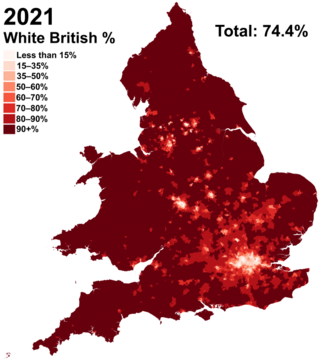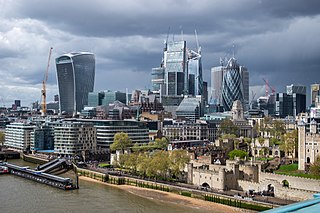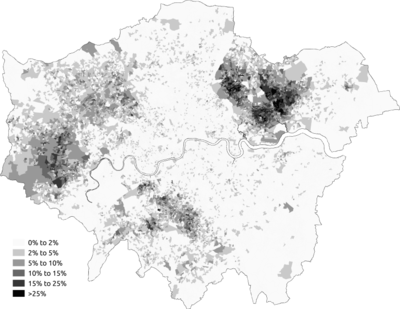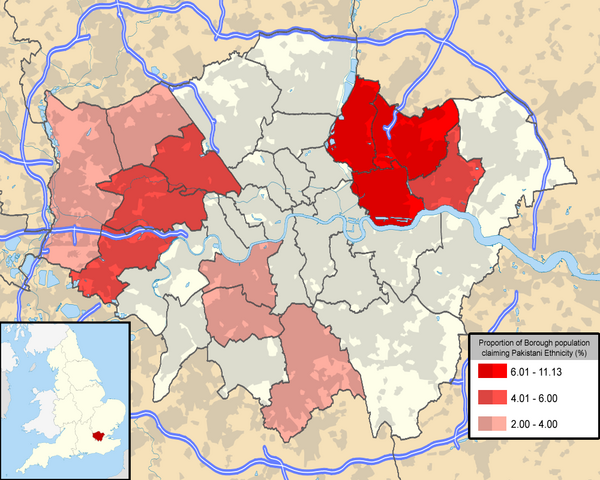
The London Borough of Redbridge is a London borough established in 1965.

Bethnal Green and Bow is a constituency in Greater London, represented in the House of Commons of the UK Parliament since 2010 by Rushanara Ali of the Labour Party.

British Chinese, also known as Chinese British or Chinese Britons, are people of Chinese – particularly Han Chinese – ancestry who reside in the United Kingdom, constituting the second-largest group of Overseas Chinese in Western Europe after France.

Islam is the second-largest religion in the United Kingdom, with results from the 2011 Census giving the population as 4.4% of the total UK population, while results from the 2021 Census recorded a population of 6.5% in England and Wales. London has the greatest population of Muslims in the country. The vast majority of Muslims in the United Kingdom adhere to Sunni Islam, while smaller numbers are associated with Shia Islam.

British Asians are British people of Asian descent. They constitute a significant and growing minority of the people living in the United Kingdom, with 6.9% of the population identifying as Asian/Asian British in the 2011 United Kingdom census. This represented a national demographic increase from a 4.4% share of UK population in 2001.

West Ham is a constituency created in 1997 and represented in the House of Commons of the UK Parliament since 2005 by Lyn Brown, a member of the Labour Party.
Somalis in the United Kingdom include British citizens and residents born in or with ancestors from Somalia. The United Kingdom (UK) is home to the largest Somali community in Europe, with an estimated 108,000 Somali-born immigrants residing in the UK in 2018 according to the Office for National Statistics. The majority of these live in England, with the largest number found in London. Smaller Somali communities exist in Birmingham, Bristol, Manchester, Liverpool, Leicester, Milton Keynes, Sheffield and Cardiff.

White British is an ethnicity classification used for the white population identifying as English, Scottish, Welsh, Cornish, Northern Irish, or British in the United Kingdom Census. In the 2011 census, the White British population was 49,997,686, 81.5% of Great Britain's total population. For the United Kingdom entirely, due to different reporting measures within Northern Ireland which includes all those who identified as British with those who identified as Irish, an amalgamated total of 52,320,080 including those who identified as White Irish in Great Britain is given making up 82.8% of the population.

Islam in England is the second largest religion after Christianity. Most Muslims are immigrants from South Asia or descendants of immigrants from that region. Many others are from Muslim-dominated regions such as the Middle East, Afghanistan, Malaysia and Somalia, and other parts of African countries such as Nigeria, Uganda and Sierra Leone. There are also many White Muslims in the country, of which most have Slavic and Balkan backgrounds, as well as some ethnic English converts.

Pakistan studies curriculum is the name of a curriculum of academic research and study that encompasses the culture, demographics, geography, history, International Relations and politics of Pakistan. The subject is widely researched in and outside the country, though outside Pakistan it is typically part of a broader South Asian studies or some other wider field. Several universities in Pakistan have departments and research centers dedicated to the subject, whereas many independent research institutes carry out multidisciplinary research on Pakistan Studies. There are also a number of international organizations that are engaged in collaborative teaching, research, and exchange activities on the subject.

British Indians are citizens of the United Kingdom (UK) whose ancestral roots are from India. Currently, the British Indian population exceeds 1.8 million people in the UK, making them the single largest visible ethnic minority population in the country. They make up the largest subgroup of British Asians and are one of the largest Indian communities in the Indian diaspora, mainly due to the Indian–British relations. The British Indian community is the sixth largest in the Indian diaspora, behind the Indian communities in the United States, Saudi Arabia, the United Arab Emirates, Malaysia and Nepal. The majority of British Indians are of Punjabi and Gujarati origin with various other smaller communities from different parts of India including Kerala, West Bengal, Bihar and Uttar Pradesh.

British Bangladeshis are people of Bangladeshi origin who have attained citizenship in the United Kingdom, through immigration and historical naturalisation. The term can also refer to their descendants. Bengali Muslims have prominently been migrating to the UK since the 1940s. Migration reached its peak during the 1970s, with most originating from the Sylhet Division. The largest concentration live in east London boroughs, such as Tower Hamlets. This large diaspora in London leads people in Sylhet to refer to British Bangladeshis as Londoni.
Thais in the United Kingdom are British citizens who trace their Thai ancestry from migrants who have migrated from Thailand or Thais residing in the United Kingdom for work or educational purposes.

London, the capital of England and the United Kingdom, has become one of the most ethnically diverse and multicultural cities in the world.

Tariq Mahmood Ahmad, Baron Ahmad of Wimbledon, is a British businessman and a Conservative life peer. He was appointed Minister of State for the Middle East, North Africa, South Asia, Commonwealth and United Nations at the Foreign, Commonwealth and Development Office.

Greater London is the administrative area of London, England, which is coterminous with the London region. It contains 33 local government districts: the 32 London boroughs, which form a ceremonial county also called Greater London, and the City of London. The Greater London Authority is responsible for strategic local government across the region, and regular local government is the responsibility of the borough councils and the City of London Corporation. Greater London is bordered by the ceremonial counties of Hertfordshire to the north, Essex to the north-east, Kent to the south-east, Surrey to the south, and Berkshire and Buckinghamshire to the west.

Urdu in the United Kingdom is the fourth most commonly spoken language. It is seen as the lingua franca for around two million British South Asians. According to the 2021 census, 270,000 people listed Urdu as their main language, an increase of 1,000 from 2011. Ethnologue reports the total number of Urdu speakers in the UK at over 400,000. Since the 1990s, the Department of Health has issued patient information in Urdu in conjunction with local authorities, which has also led other organisations, institutions and councils to publish public information in Urdu.

British Pakistanis are Britons or residents of the United Kingdom whose ancestral roots lie in Pakistan. This includes people born in the UK who are of Pakistani descent, Pakistani-born people who have migrated to the UK and those of Pakistani origin from overseas who migrated to the UK.

British Punjabis are citizens or residents of the United Kingdom whose heritage originates wholly or partly in the Punjab, a region in the Indian subcontinent, which is divided between India and Pakistan. Numbering 700,000 in 2006, Punjabis represent the largest ethnicity among British Asians. They are a major sub-group of the British-Indian and British Pakistani communities.
British Pashtuns are citizens or residents of the United Kingdom who are of Pashtun ancestry. As of the 2021 census, there were at least 48,000 Pashto-speakers living in the UK. According to other estimates, the total population of British Pashtuns is as high as 100,000, making them the largest Pashtun diaspora community in Europe.





















